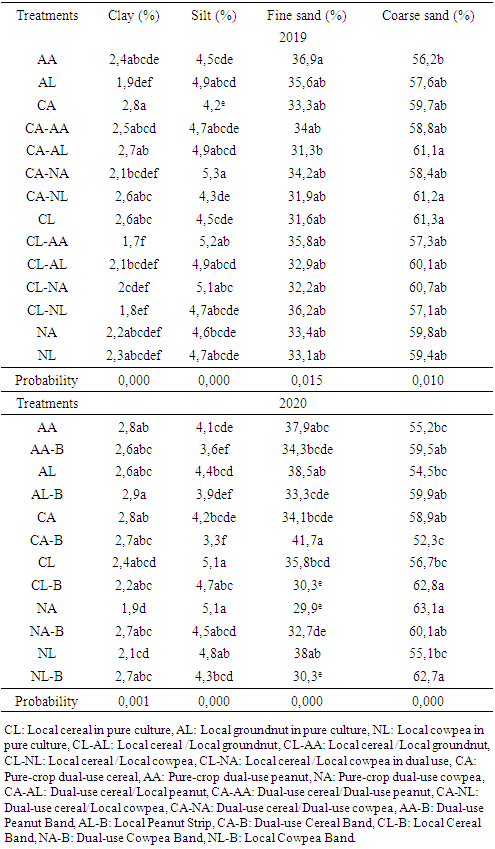-
Paper Information
- Next Paper
- Paper Submission
-
Journal Information
- About This Journal
- Editorial Board
- Current Issue
- Archive
- Author Guidelines
- Contact Us
International Journal of Agriculture and Forestry
p-ISSN: 2165-882X e-ISSN: 2165-8846
2022; 12(4): 103-114
doi:10.5923/j.ijaf.20221204.01
Received: Oct. 18, 2022; Accepted: Nov. 4, 2022; Published: Dec. 14, 2022

Increasing Agricultural Productivity with Dual-Use Crops: An Agriculture-Livestock-Environment Integration Strategy in Niger
Ibrahim Kasso A. Rahamane1, Massaoudou Moussa2, Zounon Christian Serge Félix2, Baragé Moussa3, Mahamane Larwanou1
1Department of Rural Engineering and Water and Forestry, Faculty of Agronomy, Abdou Moumouni University of Niamey, Niamey, Niger
2Department of Natural Resource Management (DGRN), National Institute of Agronomic Research of Niger (INRAN), Maradi, Niger
3Department of Plant Production, Faculty of Agronomy Abdou Moumouni University of Niamey, Niamey, Niger
Correspondence to: Ibrahim Kasso A. Rahamane, Department of Rural Engineering and Water and Forestry, Faculty of Agronomy, Abdou Moumouni University of Niamey, Niamey, Niger.
| Email: |  |
Copyright © 2022 The Author(s). Published by Scientific & Academic Publishing.
This work is licensed under the Creative Commons Attribution International License (CC BY).
http://creativecommons.org/licenses/by/4.0/

Agriculture and livestock are the main sources of food for both humans and animals. However, soil poverty, high fertilizer costs, land degradation and deforestation are major challenges in the fragile ecosystems of semi-arid areas. A study on the integration of agriculture and livestock was conducted in the Maradi region of Niger. The objective of this study is to develop integrated farming models that will improve crop productivity, livestock production and soil fertility at the lowest cost. The experimental set up is a factorial 2 x 7 x 3 in 4 Fisher blocks according to a split-split plot arrangement of 112.5m x 76m or 8 550m2. Measurements were made on stem/fan biomass and grain yield. The results of this study show that the development of crops associated with cereals and legumes (cowpeas and/or groundnuts) in alternating strips or in rotation have increased the yield of stem biomass and grain and the level of soil fertility. The effect of alternating strip cropping induced an increase in grain yield in 2020 compared to 2019. Microdose organo-mineral fertilization had positively modified (P<0.000) the yields of millet and legumes (groundnut and cowpea).
Keywords: Cereal, Legume, Strip cropping, Yield, CERRA-Maradi, Niger
Cite this paper: Ibrahim Kasso A. Rahamane, Massaoudou Moussa, Zounon Christian Serge Félix, Baragé Moussa, Mahamane Larwanou, Increasing Agricultural Productivity with Dual-Use Crops: An Agriculture-Livestock-Environment Integration Strategy in Niger, International Journal of Agriculture and Forestry, Vol. 12 No. 4, 2022, pp. 103-114. doi: 10.5923/j.ijaf.20221204.01.
Article Outline
1. Introduction
- In Sahelian countries such as Niger, 80-90% of rural populations derive their livelihoods from rain-fed agriculture and livestock. The Sahelian producer is both a farmer and a herder or agropastoralist. Livestock production plays a crucial role in income generation, providing access to diversified diets and meeting the costs of education, health and other basic household needs. These products (meat, milk, hides, etc.) now constitute a value chain that enables the survival of many households. Many technologies have been developed for agriculture and livestock. These include technologies for improving varieties (selection and varietal multiplication work), managing crop pests (work of entomological researchers), managing soil fertility and adding value to dairy products. However, agriculture and livestock production face enormous challenges and the socio-economic situation of producers remains precarious. It is characterized by a low income and a high rate of illiteracy. These factors make it difficult for producers to adopt new technologies. Niger is one of the countries south of the Sahara that have a low rate of mineral fertilizer use, with an average of less than 4kg/ha (Pandey et al., 2001; Autfray et al., 2012; Bationo et al., 2012). The development of agriculture-livestock integration systems is a way to reduce the vulnerability of producers and to respond to the main development constraints of agriculture and livestock. This theme must be a concern for all given the context of climate change that the developing world is experiencing. The integration of agriculture and livestock has been proposed since the 1990s to intensify production systems through the virtuous tripods of animal traction, organic manure and fodder production (Dugué 1989; Landais and Lhoste, 1990). The coexistence of livestock and agriculture is becoming the rule, and the problems related to their relations are clearly problems of the future (Caudron, 1989). Vermersch, (2007); Bell and Moore, (2012) report that the combination of crops and livestock is indeed recognized to secure the farm from the fluctuations of agricultural markets. Integrated farming provides resilience for producers in the face of fluctuating commodity or livestock prices. It is also an agronomic model proposed by agronomists to intensify the agricultural and livestock system. It proposes to use the by-products provided by one system as inputs for the other system. It is based on the use of traction, the production of organic manure and the production of fodder (Landais and Lhoste, 1990). The potential advantages of a close linkage between agriculture and livestock production have long been recognized by technicians, who have made it possible to enhance complementarities and limit competition between these two activities (Londais and Lhoste, 1990). However, there are very few technologies or systems for the integration of agriculture and livestock that have been developed in this area. The main objective of this study is to develop integrated farming models that will improve crop productivity, livestock production and soil fertility at the lowest cost.
2. Materials and Methods
2.1. Trial Site
- The study was conducted at the Regional Agricultural Research Center of Maradi Niger (CERRA / Maradi) station located southwest of the urban community of Maradi (capital of the region) at an altitude of 380 m between 13° 30' north latitude and 7°06'06'' east longitude. The soil is sandy with a low level of fertility. The climate of the area is Sahelo-Sudanese, characterized by a long dry season from October to May and a rainy season from June to September. The annual wind regime is characterized by alternating monsoon and harmattan winds. The first one, coming from the southwest, brings humid air masses. The second is a hot and dry wind, blowing from the North-East to the South-West during the dry season. Sandstorms are also observed at the beginning of the rainy season. Rainfall varies between 350 and 650 mm per year. The average annual rainfall over the past 30 years in the area is between 378 and 535 mm. During the two years of experimentation 2019 to 2020, the annual rainfall is 520 and 668 mm respectively.
2.2. Plant Material
- The plant material is composed of six plant species, three of which are improved and three local (Table 1). The table shows the species used in the experiment.
|
2.3. Device and Experimental Treatments
- The first experimental design is a 2 x 7 x 3 factorial in 4 Fisher blocks in a split-split plot arrangement with an area of 112.5m x 76m = 8,550m2. The 3 factors of the design include: 2 cereal varieties, including a local variety and a dual-purpose variety in the main plot, 7 cropping systems, including 4 cereal/legume association systems and 3 pure cropping systems in subplots, and 3 fertilization techniques: (Manure, manure + NPK fertilizer and a Control without fertilizer) for the cereal and (NPK, SSP and a Control) for the legume in the sub-subplot. Manure was applied to the cereal only by the micro-dosing technology at a rate of 200g (two handfuls) per packet. NPK (15-15-15) was applied at micro-doses in the plot during the weeding process and lightly plowed in at a rate of 6g for millet, 4g for cowpea, and broadcast for peanuts after the first weeding at a rate of 90g per sub-plot in the association system and 400g per sub-plot in the pure system Super Simple Phosphate (SSP) was used at 8g/pack for cowpea, 180g per subplot in the combination system and 800g per subplot in the pure system for groundnut. Cereals and cowpeas were sown at 0.75mx0.50m (26,600 bunches per hectare) and disked at 2 plants per bunch (53,200 plants per ha). Groundnuts were sown at 0.25m x 0.20m (200,000 bunches per hectare), i.e. 200,000 plants per ha.) First main plot (CL: Local cereal in pure culture, AL: Local groundnut in pure culture, NL: Local cowpea in pure culture, CL-AL: Local cereal /Local groundnut, CL-AA: Local cereal /Local groundnut, CL-NL: Local cereal /Local cowpea, CL-NA: Local cereal /Local cowpea in dual use) and second main plot (CA: Pure-crop dual-use cereal, AA: Pure-crop dual-use peanut, NA: Pure-crop dual-use cowpea, CA-AL: Dual-use cereal/Local peanut, CA-AA: Dual-use cereal/Dual-use peanut, CA-NL: Dual-use cereal/Local cowpea, CA-NA: Dual-use cereal/Dual-use cowpea.
2.4. Measurements and Observations
- Observations and measurements (growth and yields) were made on all plots. To better ensure follow-up from sowing to harvest, yield squares (1m x 1m) were selected and labeled with different colored stacks. Each color corresponds to a pile. In each plot, 6 yield squares were randomly selected with 6 stacks per yield square for millet and cowpea and 30 stacks per square for groundnut (336 yield squares or 2016 stacks monitored). Growth measurements were made on the height and number of tillers and/or stems respectively by measuring with a 4 m long graduated ruler and by counting the tillers and/or stems each week.For the yield, the grains were separated from the tops and dried for 30 days in the sun. For the tops, the total biomass of all the bunches in the yield square was weighed, then a sample of the tops was taken, weighed fresh and placed in an oven for 72 hours at 100°C and weighed for dry weight. The dry weight was used to determine the total dry biomass per yield square according to the formula: BST = BFT x Conversion rateWith:
 And BST = total dry biomass and BFT=total fresh biomass.
And BST = total dry biomass and BFT=total fresh biomass.2.5. Soil Sampling Methods
- Soil samples were augered in 2019 and 2020 from each plot to a depth of 0-20 cm at all four corners and the center of the plot. A total of 30 composite samples were formed by mixing the collected samples. A quantity of 500g was taken per composite sample and then packed to determine the physicochemical characteristics of the soils. The analyses were carried out in the laboratories of Umar Mussa Yar'Adua University, Katsina and Ahmed Bello University, Zaria, Nigeria. The parameters to be determined were particle size (Clay, Silt, Fine Sand and Coarse Sand), pH, organic carbon, organic matter, total nitrogen, available phosphorus, exchangeable bases (Calcium, Magnesium, Potassium and Sodium), sum of exchangeable bases and Carbon to Nitrogen ratio (C/N).
2.6. Physicochemical Characteristics of Soils
- Particle size was determined using the Robinson pipette method which separated and measured the following particle size fractions: clays (Exchangeable bases (Ca, Mg, K and Na) were obtained using Thermo Fisher Scientific Energy Dispersive X-ray Fluorescence (EDXRF) according to the International Atomic Energy Institute (IAEA) reference standard. The analysis was performed using the standard method which is 80% accuracy compared to the standard method less than 50% accuracy. The soil sample with a weight of 2g was ground into a fine powder using a mortar and pellet gun and then poured into a sample holder and covered with cotton to prevent pulverization. The bottom of the sample holder is made of polypropylene which is a thermoplastic. The sample holders containing the sample were run under vacuum or air for 10 minutes and inserted into the XRF spectrometer for elemental analysis. The method was calibrated using a geological or biological calibration. The analysis was performed in elemental form. The samples were allowed to run in the EDXRF spectrometer for 10 minutes each, after which the results were obtained.pH-water was measured with a pH meter in a ratio of 1/2.5 by direct reading using an electronic electrode in a distilled water diluted soil suspension (Mathieu and Pieltain, 2003).Organic carbon was determined by the method of Walkley and Black (1934) and organic matter content was determined by the following formula: OM (%) = [(Pi-Pf)/Pi]X 100 and C (%) = OM (%) /1.724 with: Pi= the initial weight of the test sample, Pf: the final test weight after calcination.Total N was determined first by mineralizing soil samples with H2SO4-Se-H2O2 mixture at 450°C for 4 h (Bremner, 1965). Then, the N content in the mineralization was determined using an automatic colorimeter (Skalar SANplus Segmented flow analyzer, Model 4000-02, Breda, Holland).Assimilable phosphorus was determined by the Bray1 method (Bray and Kurtz, 1945); the soil was attacked with Bray1 solution (xNH4F + y HCl) at pH 1.5; the filtrate was mixed with boric acid, ascorbic acid, and sulfomolybdic solution; this mixture placed in a water bath at 85°C for 10 minutes stained blue; it was read with a colorimeter at 665nm.The results of the soil characterization showed that the experimental site soils are sandy-clay textured. These soils are strongly acidic with pH ranging from 4.1 to 5.1 in 2019 and 4.8 to 5.3 in 2020. The physicochemical parameters are significantly different between the different experimental plots from 2019 to 2020 except for pH in 2020. The overall levels of these elements are mostly low across the site (Table 2 and 3). A regression and an increase of some elements (C.org, P-Braye1, N-Total) were observed from 2019 to 2022 in some plots respectively of the cereal plots and of the league plots (in pure culture and in strip).
|
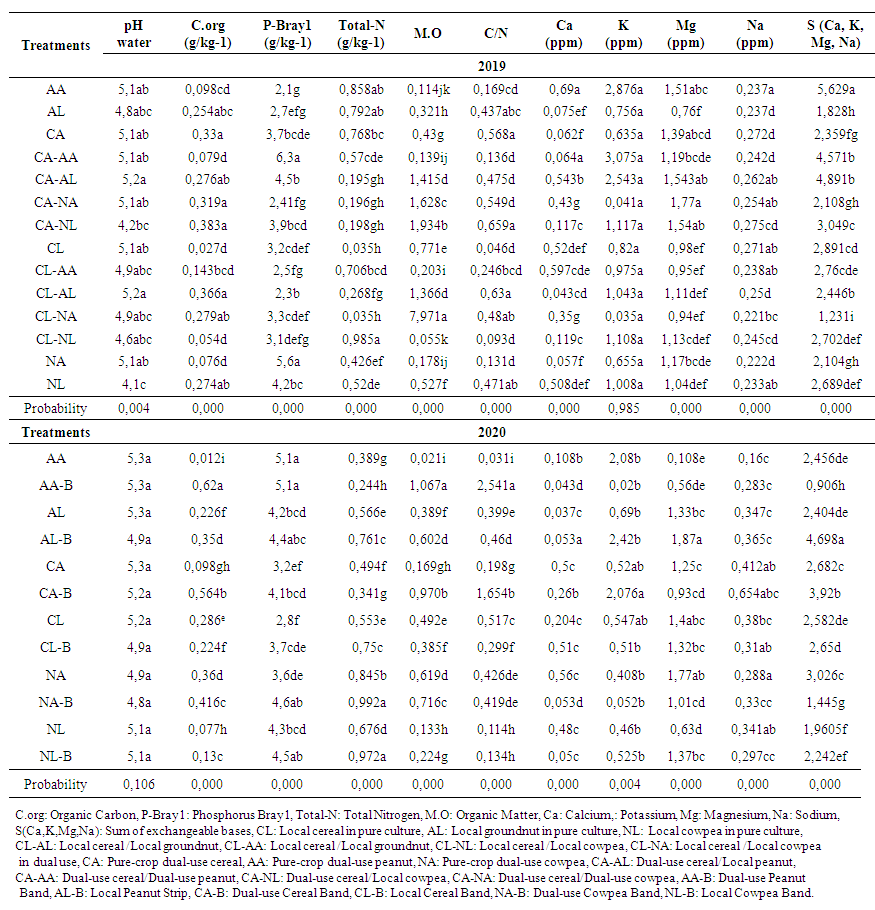 | Table 3. Chemical characteristics of the 0-20cm soil horizon in the experimental sites from 2019 to 2020 |
3. Analysis of the Data
- The data collected was entered with Excel 2013. The latter was also used to analyze certain data and to develop graphs. Then, the yield components were analyzed with MiniTAB 16 software by an analysis of variance (ANOVA) associated with General Linear Model (GLM) to compare the means of the different treatments at the 5% threshold.
4. Results
4.1. Effect of Cropping System and Treatments on Average Millet Stalk Yield
- The effect of cropping system and fertilizer application on average millet stalk yield for the entire system are presented in Table 4. The factors years, cropping system and fertilizer all had a highly significant impact on average millet stem yield from 2019 to 2020 with probabilities of P=0.000, P=0.027 and P=0.000 respectively. The results show that 2020 stem yields are higher than 2019 stem yields. Also, manure + NPK tends to give the best stem yield in both years of experimentation. Indeed, in 2019 the maximum stem yield is recorded with the variety Siaka (4141±907Kg/ha) while in 2020 it is 8738±224 kg/ha for the same variety. Manure + NPK tends to favor the development in stems than the contribution of Manure alone. The highest overall stalk yield from 2019 to 2020 is obtained with improved millet in pure cultivation (6439±2923kg/ha) with Manure + NPK input.
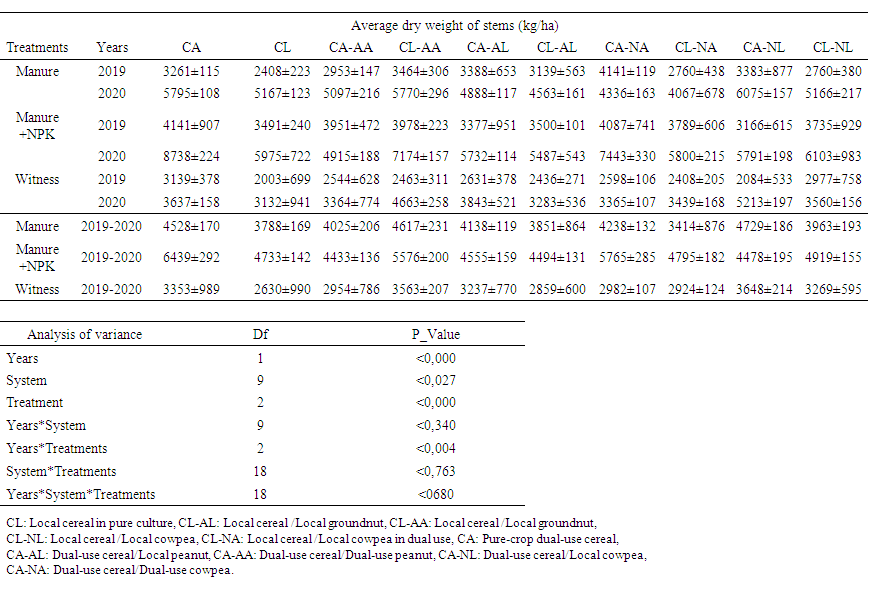 | Table 4. Effect of cropping system and treatments on average millet stem yield |
4.2. Effect of Cropping System and Fertilizers on Grain Yield
- Table 5 presents the effects of cropping system and fertilizer on grain yield. The cropping system and fertilizers had highly significant effects on grain yield (P=0.000). Thus, the effect of strip cropping induced an increase in grain yield in 2020 compared to that in 2019. The highest grain yield is recorded in 2020 with the improved millet in pure cultivation 3426±112 kg/ha. Manure +NPK tends to give the highest grain yield in both years of experimentation. Also, the overall results from 2019 to 2020 indicate that the highest average yield is 2413±406kg/ha for the improved millet compared to 1304±675kg/ha for the local millet control associated with local groundnut.
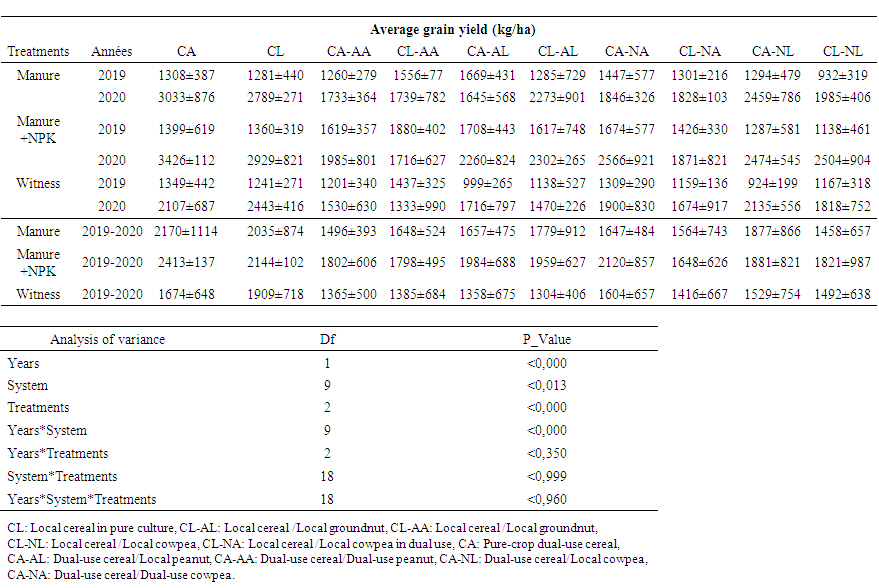 | Table 5. Effect of cropping system and treatments on grain yield |
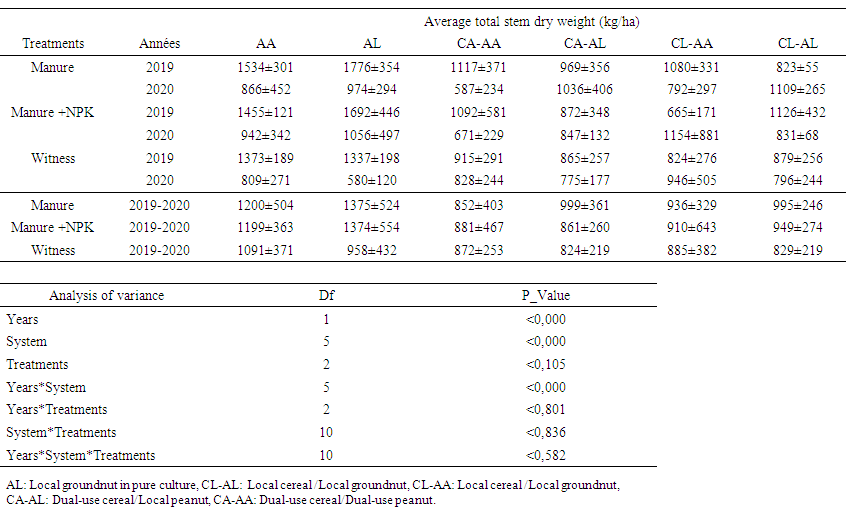 | Table 6. Effect of cropping system and fertilizers on stem yield |
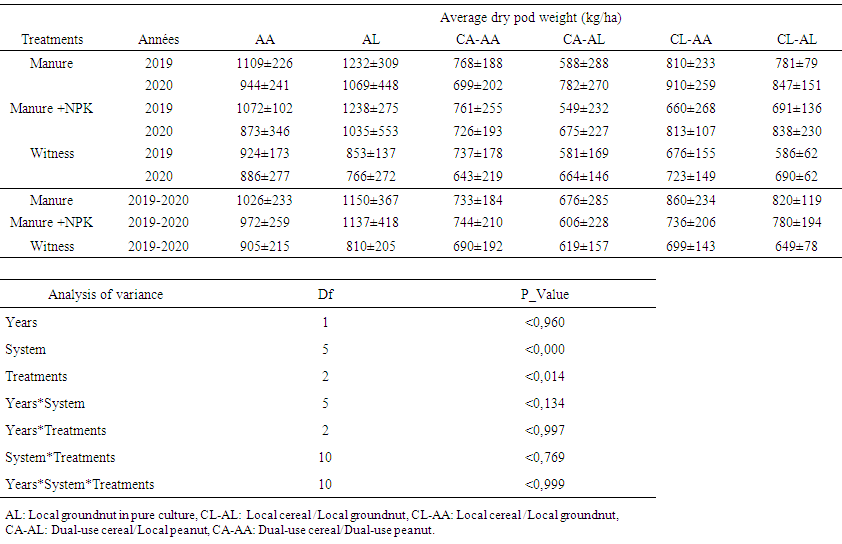 | Table 7. Effect of cropping system and fertilizers on pod yield |
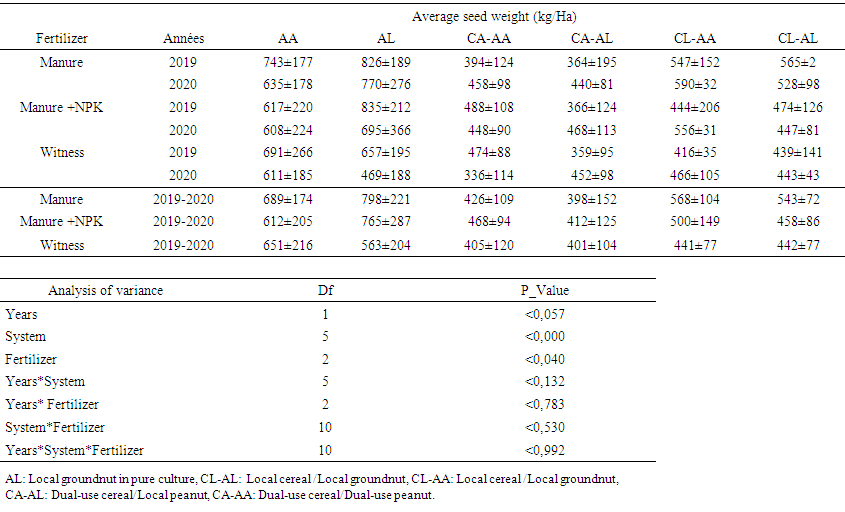 | Table 8. Effect of cropping system and fertilizer on peanut seed yield |
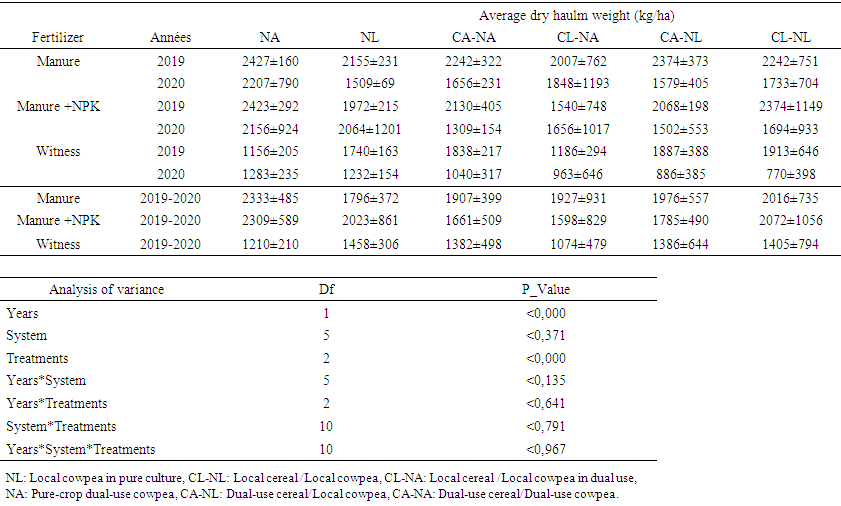 | Table 9. Effect of cropping system and fertilizer on cowpea haulm yield |
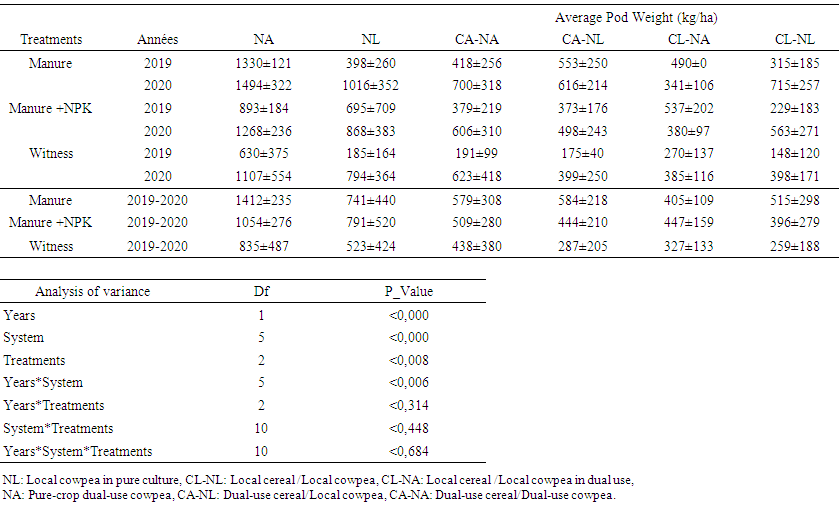 | Table 10. Effect of cropping system and fertilizers on cowpea pod yield |
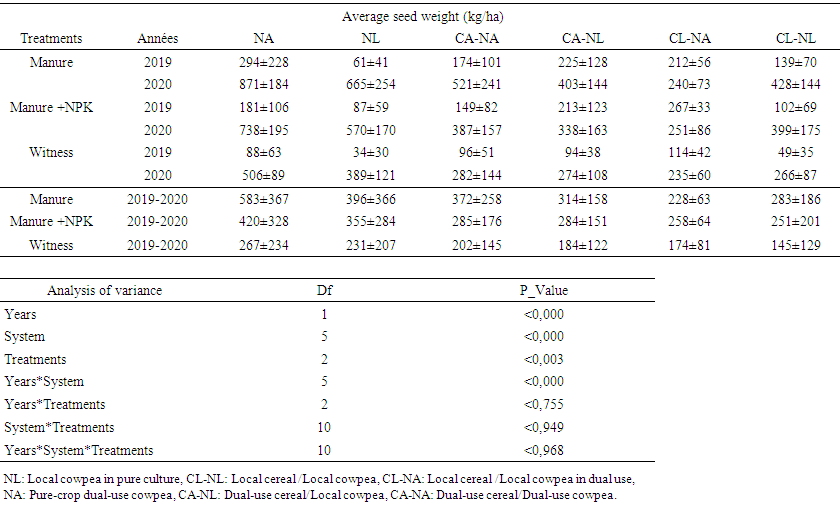 | Table 11. Effect of cropping system and fertilizers on cowpea seed yield |
5. Discussion
- Year, cropping system, and fertilizer factors all had a significant effect on average millet stem yield from 2019 to 2020 (P=0.000). Also the stem biomass yield of 2020 is significantly higher than that of 2019. These results are similar to those of Hamidou et al. (2018) who showed that millet grown in rotation with groundnut increases millet biomass by 20% than in non-rotation and that this increase indicates soil enrichment especially in N by groundnut. The highest yield of stems in this study was obtained for the millet variety Siaka in pure culture with manure + NPK. This result is higher than the one obtained by Ali (2018) who used the HKP variety in an ANR field with phospho-compost input (2737.5kg/ha); then the one obtained by Zounon et al. (2020) in an ANR field with manure+NPK input on the HKP variety (2126kg/ha) in the Sahelo-Sudanese zone. This shows that the dual-purpose variety Siaka favors fodder production with manure + NPK fertilizer more than the HKP variety.Finally, the average dry weight of grains which is the most sought after parameter by the producers, conditions the choice of the variety to be used among the producers in terms of grain yield. Grain yield motivates growers more, as they look for not only the early and resistant variety but also the one that can give more grain yield. Cropping system and fertilizer had significant effects on grain yield (P=0.000). Thus, the effect of strip cropping induced an increase in grain yield in 2020 compared to that of 2019. This increase is due not only to the fertilizer input but also to the nitrogen input by the legumes in the strips. The work of Toudou et al., (2016) specified that the atmospheric nitrogen fixed by cowpea in the first year was therefore only beneficial in the second year, especially for grains. As for Bado, (2002) and Bationo et al. (2002), legumes through their ability to fix atmospheric N can improve soil N availability and increase the yield of subsequent and associated cereals. However, Garba and Renard, (1991) reported that the positive effect of the cereal/legume association on the cereal is rarely obtained in the next year (Garba and Renard, 1991). Indeed, the results of this study are superior to those obtained by Mahamane (2012) with the varieties HKP, Zatib and CT6 in association with groundnut JL-24 and 55-437 with organic manure followed by DAP and NPK in the department of Aguié villages of Guidan Bakoye and El Guéza with values of 500kg/ha, 412kg/ha and 375kg/ha respectively. It is also higher than that obtained by Gaptia (2014) with the HKP variety in pure culture with the addition of organic manure in a farmer's school field in Dogo village (Magaria department) with 1233.33kg/ha. It is also higher than that obtained by Zounon et al. (2020) with the HKP variety in a RNA field with the addition of manure+NPK (464.1kg/ha) in the Sahelo-Sudanese zone. It is also higher than that obtained by PASADEM (2014) in Guidan Roumdji, Mayahi, Madarounfa and Tessaoua with values of 1302kg/ha, 1030kg/ha, 1600kg/ha and 1116kg/ha, respectively; and even higher than that of Rahilatou (2014) with the HKP variety (1520.83kg/ha) for a varietal test in a farmers' school field. The HKP variety is more productive in grain than the zatib and CT6 varieties on the one hand, and on the other hand the manure+NPK treatment has more effect than manure followed by DAP, in addition the pedoclimatic conditions strongly influence the grain production of the HKP variety. However, grain production is lower than that obtained by Bouzou (2009) with the variety Zatib (3000kg/ha) under compost-enriched treatment. In this context, the difference is more related to soil and climatic conditions, as we know from experience that manure + NPK has a greater effect than enriched compost, and the Zatib variety produces less grain than the HKP variety. Soil and climate conditions influence grain production in millet varieties. Year and cropping system factors significantly affected peanut stem yield in both years of the experiments (P=0.000). But fertilizer application did not have a significant effect on stem yield (P=0.105). However, the NPK fertilizer tended to give the best stem yield compared to the SSP and the control in both experimental years. Overall for both years of experimentation, the highest yield was recorded with the local groundnut in pure culture (1375±524g/ha).With regard to peanut seed yield, statistical analysis showed that the factors years, cropping system and fertilizers significantly affected peanut seed yield (P=0.000). Thus, the local variety of groundnut under pure cultivation recorded the highest grain yield in 2019. The application of SSP fertilizer increased peanut seed yield better than NPK and control. This could be due to the more soluble nature of SSP fertilizer. Indeed, the yields of SSP and NP were not significantly different. These results corroborate those of Hamidou et al. (2016) who reported that the SSP technology did not result in significantly different results than those obtained with the average NPK technology applied to the poquet. These results are superior to those obtained by Bello et al. 2019 in the Zinder region where he found a yield of 800kg/ha with the same variety. However, these results are inferior to those obtained by Bangata et al., 2013. Fertilizer application had a significant impact on cowpea haulm yield in contrast to the cropping system which did not significantly affect cowpea haulm yield. However, the highest average haulm yield was obtained with the improved cowpea under pure cultivation with NPK application in 2019. Ouedraogo and Hien (2015) reported that better aboveground biomass production is observed with the application of organo-mineral fertilizer. Several others reported that phosphorus plays a determining role in legume and cereal production (Dakora & Keya., 1997; Twomlow et al., 2004; Valluru et al., 2010). Regarding sheath yield, year, cropping system and fertilizer factors had a significant effect on cowpea seed yield in both years of experiments. This study showed a positive effect of fertilizer use on increasing cowpea yields. Indeed, the best average grain yield was obtained in improved cowpea (871±184kg/ha) with NPK application in 2020. In general, grain yields in 2020 are higher than those in 2019. The low cowpea yields in 2019 may be explained by low soil fertility. Some et al. 2014 indicates that application of compost increases seed yield. The work of Bado (2002) shows that the effects of organo-mineral fertilizers on crop yields are more pronounced in the second year. All the high vines and grain yields of cowpea were obtained with the improved variety. This is explained by the dual-use characteristics of this variety, including the production of seeds for human consumption and tops for animal feed. Toudou et al. (2016) reported that dual-purpose varieties allow seed production for human consumption and for agriculture-livestock integration in the Sahelian zone, as cowpea haulms are an important source of protein for livestock. Microdose organic and mineral fertilizers positively affected millet and legume (groundnut and cowpea) yields. All of the significant yields were obtained on the plots that received microdose fertilizer in contrast to the control plots. This performance of the microdose would be linked to the concentration of nutrients at the level of the root systems, which would improve accessibility and efficiency of use (Muehlig-Versen et al., 2003) and would reduce losses. Several studies have shown the positive impact of microdosing on both yield increase and income increase for producers, as it allows to decrease the defense to organic and mineral fertilizers. The work of Tabo et al. (2005), Aune et al. (2007) and Taonda et al. (2008) showed the positive effect of microdose in increasing the income of producers. Microdose NPK (6g of NPK applied per packet at sowing) and 30kg N/ha (applied in two fractions) also showed a positive result (Hamidou et al., 2016). Microdosing technology has induced an increase in cereal yield of more than 120% in Burina-Faso, Mali and Niger (Tabo et al., 2011).
6. Conclusions
- This study evaluated the effect of cereal-legume crop succession, alternate strips and microdosing on millet, groundnut and cowpea yields. Microdosing of organic and mineral fertilizer increased biomass and grain yields of millet, cowpea and groundnut. Indeed, the improved cereal (Siaka) and legume (TN5-78) varieties would be better for seed and stalk biomass production.The results show that the development of crops associated with cereals and legumes (cowpeas and/or groundnuts) in alternating strips or in rotation, as opposed to farmers' practice where cowpeas and groundnuts are scattered in the millet field, has made it possible to increase human and animal nutrition and the level of soil fertility. The cultivation of legumes improves the level of soil fertility in the cereal/legume cropping system and would increase the yield of stalk biomass and grain. The contribution of mineral (NPK) and organic (manure) fertilizer in microdose in the cereal/legume cultivation system allows to reduce the defense for the purchase of fertilizer on the one hand. On the other hand, it allows to obtain a better biomass and grain yield. It would be important to sensitize producers to adopt the technique of combined cereal/legume strip cropping (improved varieties) and microdose mineral and organic fertilization in order to improve soil fertility, crop yields and income.
ACKNOWLEDGEMENTS
- The authors thank the PARC/DAD project for its financial support and the Regional Agricultural Research Center of Maradi Niger for its technical support in the realization of this work.
 Abstract
Abstract Reference
Reference Full-Text PDF
Full-Text PDF Full-text HTML
Full-text HTML
